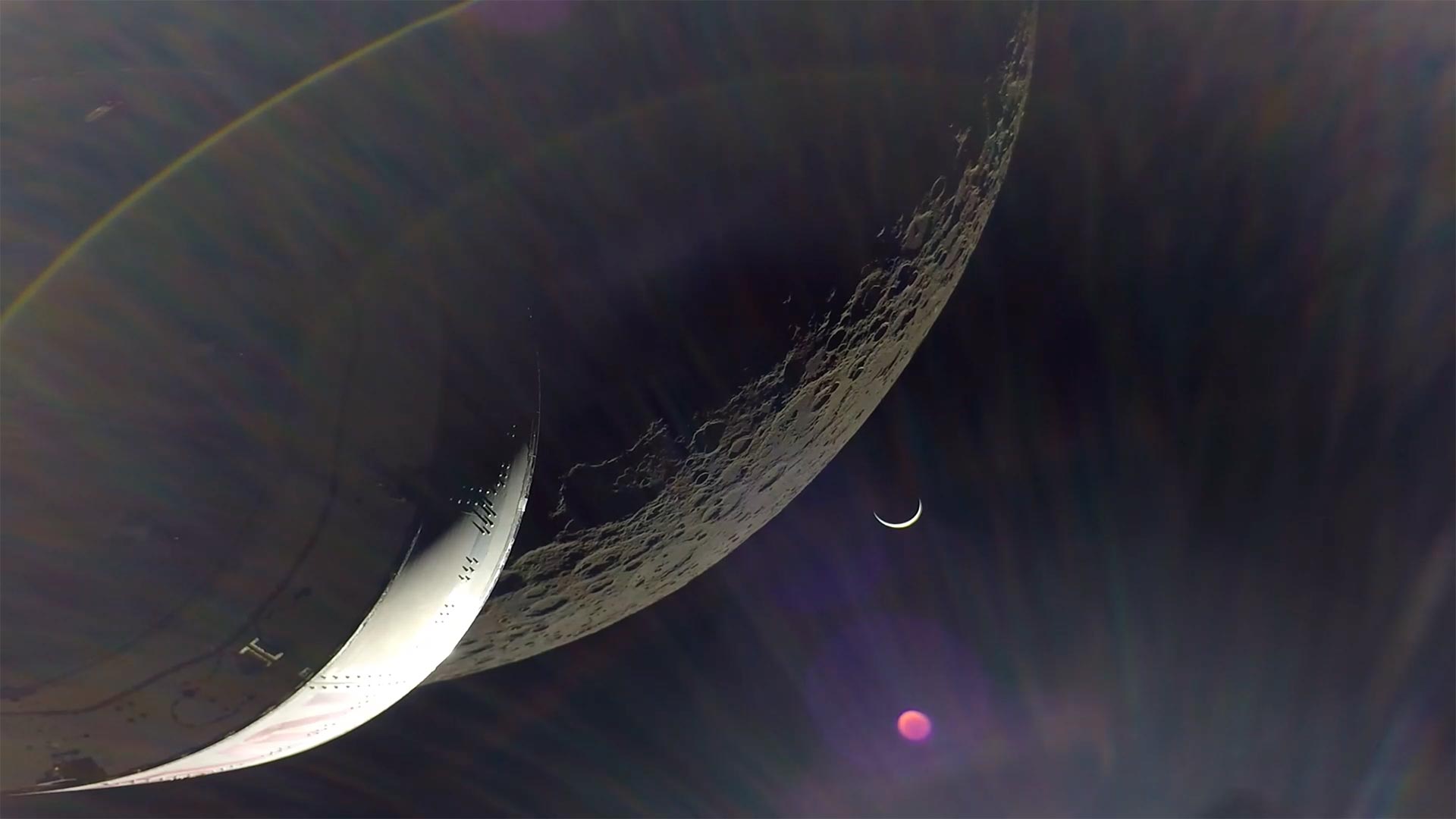On flight day 20, Orion captured the crescent Earth in the distance as the spacecraft regained communications with the Deep Space Network following its return powered flyby on the far side of the Moon. The spacecraft will splash down on Sunday, December 11. Credit: <span class=”glossaryLink” aria-describedby=”tt” data-cmtooltip=”
NASA
Established in 1958, the National Aeronautics and Space Administration (NASA) is an independent agency of the United States Federal Government that succeeded the National Advisory Committee for Aeronautics (NACA). It is responsible for the civilian space program, as well as aeronautics and aerospace research. Its vision is "To discover and expand knowledge for the benefit of humanity." Its core values are "safety, integrity, teamwork, excellence, and inclusion."
” data-gt-translate-attributes=”[“attribute”:”data-cmtooltip”, “format”:”html”]”>NASA
On day 22 of the 25.5-day Artemis I mission, the Orion spacecraft continues its journey back to Earth. Flight controllers and engineers continue to test the spacecraft and its systems in preparation for future flights with a human crew aboard.
The second part of the propellant tank slosh development flight test was conducted by engineers. This propellant slosh test is specifically scheduled during quiescent, or less active, parts of the mission. Propellant motion, or slosh, in space is difficult to model on Earth because, due to the lack of gravity, liquid propellant moves differently in tanks in space than on Earth.
On flight day 20, Orion approached the Moon ahead of the return powered flyby burn that committed the spacecraft to splashdown on Sunday, December 11. Credit: NASA
For the test, flight controllers need to fire the reaction control system thrusters when propellant tanks are filled to different levels. The reaction control thrusters used are located on the sides of the service module and can be fired individually as needed to move the spacecraft in different directions or rotate it into any position. Each of these engines provides about 50 pounds of thrust. Engineers measure the effect the propellant sloshing has on spacecraft trajectory and orientation as Orion moves through space.
The test was first performed after the outbound flyby burn, and now again after the return flyby burn, to compare data at points in the mission with different levels of propellant onboard. Approximately 12,060 pounds of propellant has been used, which is 215 pounds less than estimated prelaunch, and leaves a margin of 2,185 pounds over what is planned for use, 275 pounds more than prelaunch expectations. The first prop slosh test objective was completed on day eight of the mission as Orion prepared to enter the distant retrograde orbit.
On flight day 20, Orion approached the Moon ahead of the return powered flyby burn that committed the spacecraft to splashdown on Sunday, December 11. Credit: NASA
A few key milestones for Orion remain, including the entry system checkouts and propulsion system leak checks on mission days 24 and 25, respectively.
Orion will travel at around 25,000 mph (40,000 km/h) while reentering Earth’s atmosphere, testing the world’s largest ablative heat shield by reaching temperatures up to 5,000 degrees <span class=”glossaryLink” aria-describedby=”tt” data-cmtooltip=”
Fahrenheit
The Fahrenheit scale is a temperature scale, named after the German physicist Daniel Gabriel Fahrenheit and based on one he proposed in 1724. In the Fahrenheit temperature scale, the freezing point of water freezes is 32 °F and water boils at 212 °F, a 180 °F separation, as defined at sea level and standard atmospheric pressure.
” data-gt-translate-attributes=”[“attribute”:”data-cmtooltip”, “format”:”html”]”>Fahrenheit (2,800 degrees <span class=”glossaryLink” aria-describedby=”tt” data-cmtooltip=”
Celsius
The Celsius scale, also known as the centigrade scale, is a temperature scale named after the Swedish astronomer Anders Celsius. In the Celsius scale, 0 °C is the freezing point of water and 100 °C is the boiling point of water at 1 atm pressure.
” data-gt-translate-attributes=”[“attribute”:”data-cmtooltip”, “format”:”html”]”>Celsius) – approximately half the temperature of the surface of the sun. The heat shield is located at the bottom of the Orion capsule, measuring 16.5 feet (5 meters) in diameter, and sheds intense heat away from the crew module as Orion returns to Earth. The outer surface of the heat shield is made of 186 billets, or blocks, of an ablative material called Avcoat, a reformulated version of the material used on the Apollo capsules. During descent, the Avcoat ablates, or burns off in a controlled fashion, transporting heat away from Orion. Learn more about Orion’s heat shield in the Artemis I reference guide.
Artemis All Access is your look at the latest in Artemis I, the people and technology behind the mission, and what is coming up next. This uncrewed flight test around the Moon will pave the way for a crewed flight test and future human lunar exploration as part of Artemis. Credit: NASA
On Thursday, December 8 at 5 p.m. EST, NASA will host a briefing to preview Orion’s return scheduled for Sunday, December 11 and to discuss how the recovery teams are preparing for entry and splashdown. The briefing will be live on NASA TV, the agency’s website, and the NASA app.
Watch the latest episode of Artemis All Access (video embedded above) for a look back at recent mission accomplishments and a preview of splashdown, including parachute information.
Source link
Related
























